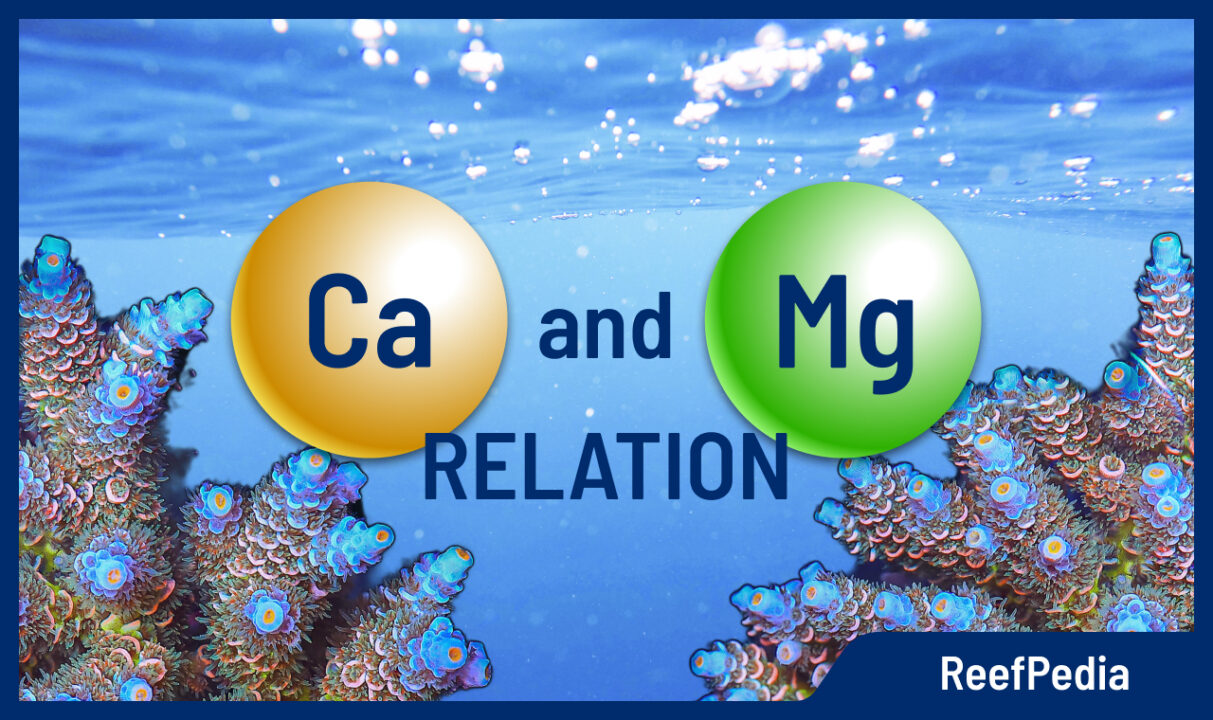Table of Contents
The presence of magnesium and calcium
Magnesium (Mg) and calcium (Ca) are elements widely distributed in the Earth’s crust (Mg 2.09%, Ca 3.63%). In nature, magnesium plays a significant role as one of the components of chlorophyll, the green pigment mainly found in the leaves and stems of plants.

Meanwhile, calcium ranks fifth in terms of abundance in the Earth’s crust, occurring in the form of numerous silicates and aluminosilicates.
Both of these elements, magnesium and calcium, play a crucial role in the saltwater aquarium. They are significant members of the group of macroelements in marine aquarium keeping, where magnesium ranks second and calcium fourth in terms of quantity.

Properties of magnesium and calcium
In chemical terms, calcium (Ca) and magnesium (Mg) are placed in the second group of the periodic table of elements (the Mendeleev table), also known as the alkaline earth metals group.
Their position in the periodic table is not accidental. Elements in the same group exhibit numerous similarities in both chemical and physical properties. It is these similarities that determine their role in aquatic ecosystems.
Interestingly, other macroelements present in seawater, such as strontium (Sr), and trace elements like barium (Ba), also belong to the same group of the periodic table.

Returning to magnesium and calcium, their similar properties have a significant impact on the chemical balance in the aquarium. They play a crucial role in maintaining the stability of the environment for marine organisms. Therefore, their presence and proper proportions are essential for ensuring the health and proper functioning of the entire aquarium ecosystem.
Synergy between magnesium and calcium
Calcium is one of the most important, if not the most important, minerals in seawater. It plays a crucial role in the formation of many marine organisms, including corals, mollusks, macroalgae, and bacterial biofilms. Combined with carbonates, it forms the skeletal structure of corals.
On the other hand, magnesium is important for the growth of various marine organisms, including calcareous algae. Magnesium also contributes to the formation of coral skeletons, but one of its key roles is to assist animals and algae in the process of calcium uptake. Some living creatures, such as calcareous algae, mollusks, or sea urchins, absorb larger amounts of magnesium.
| Although magnesium is not needed by animals as much as calcium and carbonates, maintaining a stable calcium content is not possible without the appropriate level of magnesium. |
The synergy between these elements affects numerous aspects of water chemistry in a saltwater aquarium. A key effect of their interaction is supporting the construction of coral skeletons, maintaining a stable pH level, and preserving the ionic balance of seawater. These parameters play a fundamental role in the context of saltwater aquarium keeping, which will be further discussed in the subsequent part of the article.
The process of building the skeleton of corals – synergy between magnesium and calcium
The formation of coral skeletons is a complex process primarily based on mineralization (the capture of ions from the environment and their incorporation into crystalline structures). When the formation of crystalline structures is biologically controlled, it is referred to as biomineralization. Both mineralization and biomineralization are precisely controlled from the moment crystals begin to form.
Calcium participates in biomineralization processes. It requires not only the availability of calcium but also ionic balance with other minerals, such as magnesium, which support and regulate these processes.
Strict control of this process allows for the creation of mineral structures with desired properties, adapted to the function of the produced hard tissue. Although the chemical composition of these tissues is similar, their structure and mechanical properties vary significantly. This may result from the tissues’ adaptation to their functions. Precise control of the formation of these structures is important starting from the early stages and has a real impact on the shaping of the final tissues.
You can find more about methods to accelerate coral growth in a separate article.

Stable pH process – synergy between magnesium and calcium
Magnesium and calcium are also responsible for maintaining the appropriate pH and have the ability to buffer saltwater. This process is related to carbonate hardness (dKH), and pH stabilization in this case involves the reaction of calcium ions (Ca2+) with carbonate ions (CO32-) and bicarbonate ions (HCO3–).
Ionic balance – synergy between magnesium and calcium
Magnesium, occurring in the form of magnesium ions (Mg2+), helps maintain ionic balance and calcium metabolism, which also affects pH stability. However, ionic balance also has a significant impact on the solubility of other elements. Changing the magnesium concentration in the water can affect the overall ionic balance of seawater. This, in turn, can alter the way ions are adsorbed (absorbed) and desorbed (released) from various surfaces, including marine sediments.
One example is the influence of magnesium presence on the solubility of iodine. Magnesium ions (Mg2+) can form complex compounds in combination with iodide ions (I–). The result of such a combination can be an increase or decrease in the solubility of iodine. The direction of this action depends on many factors, such as water pH, the presence of other ions, and temperature.
⬆️ Higher levels of magnesium promote better dissolution of iodide ions, facilitating their adsorption (absorption) by marine organisms.
On the other hand, calcium can influence the bioavailability of other nutrients important for marine animals by forming chemical complexes. Calcium tends to form stable complexes with anions, affecting the solubility of heavy metals in water. Metals such as lead, cadmium, or copper can form insoluble carbonate or calcium carbonate complexes, limiting their mobility and toxicity (sediments in the aquarium).
Calcium ions can also react with phosphate ions, forming insoluble calcium salts (Ca3(PO4)2), which precipitate and often accumulate at the bottom of the aquarium. As a result, the availability of phosphates for marine organisms as a nutrient decreases.
Appropriate proportions of magnesium and calcium in seawater
There is a known relationship between the formation of skeletal structures depending on the ratio of calcium ions (Ca2+) to carbonate ions (CO32-). Scientific literature suggests that a very significant effect of the interaction between magnesium ion (Mg) concentration and the Ca:CO3 ratio has been observed.
| Important: Magnesium has a greater influence on the instability of CaCO3 than the Ca/CO3 ratio itself. |
Their levels and ratio to each other significantly influence the growth and health of animals in the saltwater aquarium. Maintaining the recommended level of magnesium enables animals and algae to efficiently absorb calcium, allowing for the efficient building of the skeleton.
![]() We recommend maintaining the magnesium level within the range of 1250-1450 ppm, with the optimal value being 1350 ppm.
We recommend maintaining the magnesium level within the range of 1250-1450 ppm, with the optimal value being 1350 ppm.
![]() The calcium level should be within the range of 380-460 ppm, with the optimal value being 440 ppm.
The calcium level should be within the range of 380-460 ppm, with the optimal value being 440 ppm.
![]() We recommend maintaining the KH (carbonate hardness) level within the range of 7-9 °dKH, with the optimal value being dependent on the coral population in your aquarium:
We recommend maintaining the KH (carbonate hardness) level within the range of 7-9 °dKH, with the optimal value being dependent on the coral population in your aquarium:
- reef tank with corals SPS: 6.5 – 7.5 °dkH
- reef tank with mixed corals: 7.0 – 9.0 °dkH
Summary
The synergy between calcium and magnesium influences numerous aspects of water chemistry. Calcium and magnesium not only support the construction of coral skeletons but also play a crucial role in maintaining a stable and healthy aquatic environment by stabilizing pH and maintaining ionic balance in seawater.
* The term “beryllium” originates from the name of the first element placed at the top of the second column of the periodic table (Be – beryl).
About author

Magdalena Metzler
Privately, I am a mother and a lover of nature and sport. My main interest is quantum chemistry, which hides a whole lot of unsolved mysteries and connections, which is extremely exciting from a scientific point of view.
In my scientific career, I have conducted international projects focused on innovative solutions for many branches of business, e.g. automotive, construction, and now, of course, marine aquaristics.
Working at Reef Factory gave me a passion for marine aquaristics, which I can develop every day, building a chemistry department and creating products that will help aquarists take care of tanks and ensure the highest safety of animals. One of the most exciting memories of working at Reef Factory is the commissioning of the ICP-OES spectrometer, which analyzes the elemental composition of seawater. The method of analysis in ICP is based on an analytical technique, which is a combination of my passion for quantum chemistry and marine aquaristics.
I hope you find my articles on ReefPedia interesting and helpful! Happy reading :))

